MacBook Pro gets sluggish gradually, like all other PCs. Fortunately, you don't have to keep using a slower Mac when several techniques are available to optimize Mac performance. What are the tested fixes to optimize Mac performance? Let's see the top 8 fixes below!
| Workable Solutions | Step-by-step Troubleshooting |
|---|---|
| Fix 1. Empty Mac Trash | Hit the Apple logo in the menu bar, select About This Mac, and select the Storage tab...Full steps |
| Fix 2. Quit Not Using Apps | Visit Finder > Applications. Hit the grid symbol, and opt for Date Last Opened in the menu...Full steps |
| Fix 3. Keep Software Updating | Select System Preferences and see if the Automatically check for updates is ticked...Full steps |
| Fix 4. Manage Startup Programs | Visit the Apple menu, select System Preferences, and open Users & Groups...Full steps |
| Other Proven Fixes | Optimize Mac settings, clean startup disk, run First Aid from Disk Utility, and reset PRAM...Full steps |
Your MacBook Pro might be sluggish due to an older OS or an entire hard disk - mainly when MacBook slow after Ventura update. But if you have purchased the latest MacBook, its sluggishness could be a malware infestation or others. However, these are the situations when you must optimize Mac performance:
😫Several background processes: Heavy-duty MacBook Pros often fail to inform you if a process takes up massive memory or CPU. It's true if you're running an infected or crashed app. In this case, you should check RAM on Mac and free up your MacBook.
🎭An adware or malware infestation: Macs may get viruses sometimes! Therefore, to ensure a malware infection doesn't make your Mac sluggish, scan it daily with a malware-scanning tool.
💻Older macOS or applications: You must constantly verify if the OS and the installed applications are updated. The latest versions of the apps and OS mainly operate expeditiously and include minimal bugs and security patches, which cause slackening.
Optimize Mac Performance: 8 Tested Fixs
Nobody prefers a non-trustworthy, slow, or buggy Mac! Therefore, becoming familiar with Mac optimization will help you save time as well as cash. Let's have a look at the fixes below to improve the performance of your Mac.
Fix 1. Optimize Performace via Emptying Trash
Have you been suffering from constrained space on your Mac? Or Mac deleted files but still no space? The best way to obtain space is to "Empty Trash" or force empty Mac Trash.
The latest macOS versions can set the Trash to delete items automatically every 30 days. Go through the steps below to empty the trash folder:
Step 1. Hit the Apple logo in the menu bar.
Step 2. Select "About this Mac."
Step 3. Select "Storage".
Step 4. Hit the "Manage" option.
Step 5. Toggle on "Empty Trash", which will clean up the items you have in the Trash after 30 days.
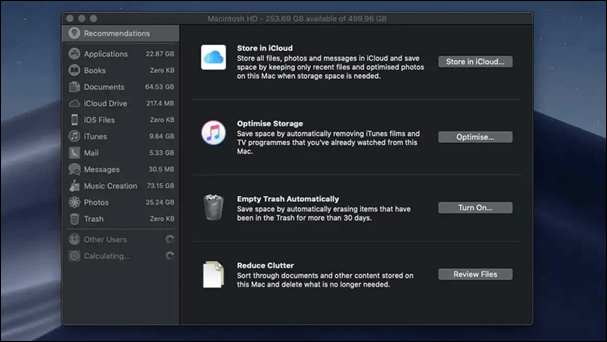
On some occasions, when Mac users want to empty the Trash to save storage space, they may find they can't empty the Trash on Mac when they click empty. In this case, you can read the article behind to solve this issue.

Help! Mac Trash Bin Won't Let Me Empty it, How to Fix?
This article is mainly about the reasons for this annoying issue and how to solve this problem in four solutions. Read more >>
Fix 2. Quit Not Using Apps to Optimize Mac Performance
You may optimize your Mac by verifying your HDD and quit, or force quit applications not in use. You may get rid of the installed apps quickly with these below-mentioned steps:
Step 1. Visit "Finder > Applications". Hit the grid symbol, and opt for "Date Last Opened". It will help sort every application by the date you used them.
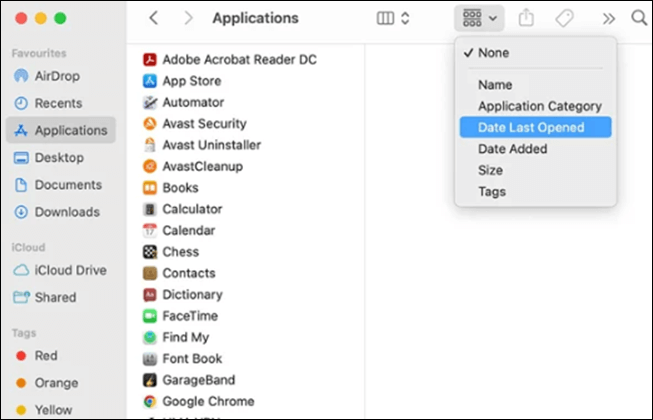
Step 2. Clean the Trash after moving any outdated apps there. This will stop outdated programs and their files from consuming memory on your Mac and slowing it down.
If you don't use the program often but don't want to delete it, you can force quit in Mac Activity Monitor it so that it doesn't run in the background, taking up unnecessary CPU and cache.
Fix 3. Keep Software Updating on Mac
It's essential to perform a software update for your macOS. In case you're operating any latest version of macOS, open "System Preferences" and hit the "Software Update" option. On the other hand, select the Apple symbol in the menu bar, and opt for "Software Update". You need to give your Mac some time to see if there's any update available.
Subsequently, you need to see if your applications need updating. To verify if there's an update for the apps you have installed from the App Store, open it, and select updates. Additionally, make sure that macOS maintains its updates with these steps:
Step 1. Select "System Preferences > App Store" and see if the "Automatically check for updates" is ticked.
Step 2. Tick the box of install app updates, which will make sure the apps are the updated ones.

Sometimes Software Update crashes and fails to check if your Mac can be upgraded. This article can help you solve this problem.

Mac Software Update Not Working | 6 Proven Ways to Fix It [macOS Sonoma Included]
This article discusses the possible causes and solutions for Mac Software Update not working issue. Read more >>
Fix 4. Optimize Mac Performance: Manage Startup Programs
Startup programs or login items are known as scripts. They allow some applications to start automatically every time you boot your MacBook Pro. Your PC is anticipated to have some startup items.
But if they're not kept in check, startup programs can drain your battery life and take out the processing power. The Mac will lag as a result of it. Follow the steps below to check Mac startup issues:
Step 1. Visit the Apple menu located in the menu bar.
Step 2. Select "System Preferences" and open "Users & Groups".
Step 3. Click on "Login Items".
Step 4. Eliminate anything you don't want to launch while booting your Mac. Choose and stop apps from opening startup Mac.

Share this article on social media to help others learn how to optimize Mac performance.
Fix 5. Optimize Settings on Your MacBook Pro/Air
macOS can assist you in obtaining maximum space on your MacBook Pro or Air by optimizing its storage. You can retain photos, files, videos, and email attachments whenever space is required in iCloud. All these can be available on demand.
If you need those original files, download them, as they don't consume much space on your MacBook. Your Mac consistently has the most recent files and optimal copies of your images. Follow the steps below to optimize the settings on your MacBook:
Step 1. Select Apple menu > "System Settings". After that, hit the General option located in the sidebar.
Step 2. Hit the storage option on the right side.
Step 3. Analyze the suggestions and choose how to make your Mac's storage more efficient.

Fix 6. Clean Startup Disk to Speed Up MacBook Pro/Air
If you have ever received this message "Mac startup disk full", you must clean it to optimize your MacBook's speed. You may eliminate outdated backups and improve storage. Follow the steps below to remove old backups to fix the startup disk:
Step 1. The Finder window needs to be opened.
Step 2. Select the "Go" in the menu bar.
Step 3. Select "Go to Folder".
Step 4. Tap the "Return" key after typing this command: /Library/Application Support/MobileSync/Backup.
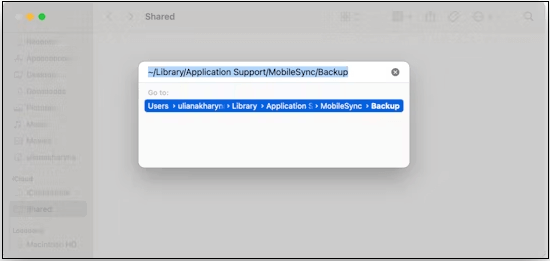
If you can't find the Mac startup disk in Disk Utility, this article can solve the problem.

Fix No Startup Disk on Mac Without Losing Data
Follow the advice to fix each startup disk error in different situations and recover MacBook data with EaseUS. Read more >>
While cleaning the startup disk to speed up the MacBook, you may face data loss while eliminating outdated files. It is possible to recover Trash Mac, but you may lose them forever if the situation worsens. But with professional data retrieval software, you can recover permanently deleted files Mac quickly.
EaseUS Data Recovery Wizard for Mac is a top-notch data retrieval software that can recuperate every type of lost data from emptied Trash bins and accidental deletions.
Follow the steps below to recover lost or deleted files after cleaning up your startup disk on Mac.
Step 1. Scan for lost data on the fusion drive
Select the Fusion Drive partition where you lost data and files. Click the "Search for lost files" button. If you don't know which partition is the fusion drive, click the "search from your disk" anchor text to check the partition name.
Note: Before data recovery, you'd better click "Disk Backup" from the left sidebar to create a backup of your Fusion drive to avoid further data loss. After backing up the Fusion Drive, the software can recover data from your Fusion Drive backup, and you can use it again.

Step 2. Find lost files after the scan
EaseUS Data Recovery Wizard for Mac will immediately scan your Fusion disk partition and display the scanning results. You can filter the files through the file type and path.

Step 3. Recover files on the fusion drive
In the scan results, select the file(s) to preview. Then, click the "Recover" button to get them back.

Fix 7. Run First Aid from Disk Utility
If the aforementioned fixes aren't working, you need to ensure the Mac is in good condition. You can check this by operating Disk Utility with the steps below:
Step 1. Open "Disk Utility" in Apps or Utilities.
Step 2. Choose your startup drive, which is located on the left side.
Step 3. Select the "First Aid" tab on the right side.
Step 4. Hit the verify button.
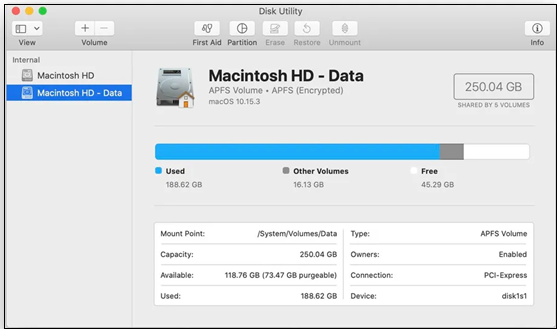
If the disk utility finds issues with your drive, you have to boot it from a distinct volume to execute the repairs. Recovery Mode serves this purpose! Hold down the power button at startup to start Mac in Recovery Mode. You may now access Disk Utility!
Fix 8. Reset PRAM and SMC Regularly
You may fix several performance issues and optimize Mac speed by resetting PRAM and SMC regularly. Follow the steps below to reset SMC MacBook Pro with a removable battery:
Step 1. Shut down your Mac.
Step 2. Unplug the power cord.
Step 3. Remove its battery.
Step 4. Hold the power button for 5 seconds, and after that, put the battery back, and plug it again.
Follow the steps below to reset the SMC for the MacBooks with a non-removable battery:
Step 1. Switch your MacBook off to reset the SMC.
Step 2. Hold down the "Shift + Control + Option" keys for 10 seconds.
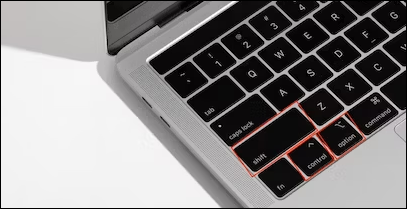
Step 3. Press & hold the power button of the Mac for 10 seconds.
Step 4. Release all those keys, and switch your MacBook on again.
In order to reset PRAM, you need to follow these steps:
Step 1. Shut down your MacBook.
Step 2. Press down "Command + Option + P" after pressing the power button.
Step 3. Release those buttons after a few seconds.
This fix may boost Mac performance issues and make it faster.
Conclusion
You must identify the problem and take measures if your Mac runs at the speed of a Mac that is five times its age. But the sheer amount of cleaning you have to do might be intimidating. The aforementioned fixes are hassle-free to perform, and one of them will optimize Mac performance. However, if you face data loss while fixing this optimization error, you may install EaseUS Data Recovery Wizard for Mac to recover every data type.
Optimize Mac Performance FAQs
These are the below-mentioned FAQs to optimize Mac performance:
1. How do I optimize my Mac M1 performance?
You may conduct a macOS system update to optimize Mac m1 performance. These are the steps to consider:
Step 1. Open the Apple menu and visit "System Preferences> Software update".
Step 2. Wait some time while the MacBook searches for updates.
Step 3. Hit the update now if there's any update shown.
2. What does the "Optimizing Your Mac" option mean?
This optimization notification usually pops up after installing a system software update, signing in with an unfamiliar user account, or restarting the Mac after extended inactivity.
3. Does cleaning storage speed up my MacBook Pro?
Your Mac may run much slower due to restricted disk space and unusable programs caused by file clutter. Cleaning up your Mac can assist in solving these problems and speed it up. Examples of cleaning up your Mac include deleting garbage files or persistent trash data.
4. Can I update RAM on Mac?
It is contingent upon your Mac version regarding how to update your RAM; some models, like the MacBook Air, cannot have RAM upgrades made. When upgrading the RAM on a Mac, the case is typically taken off, and the old RAM chips are swapped out for new ones.
Was This Page Helpful?
Brithny is a technology enthusiast, aiming to make readers' tech lives easy and enjoyable. She loves exploring new technologies and writing technical how-to tips. In her spare time, she loves sharing things about her game experience on Facebook or Twitter.
Related Articles
-
Solved: CMD.exe/CMD Keeps Popping up in Windows 10
![author icon]() Tracy King/2024-01-11
Tracy King/2024-01-11 -
How to Use Git Delete File [Full Tutorial for Git]
![author icon]() Dany/2024-01-11
Dany/2024-01-11 -
How to Fix Game Stuttering on Windows 11 [Step-by-Step Guide]
![author icon]() Daisy/2024-01-11
Daisy/2024-01-11 -
Free PDF Editor - Top 6 Best Free PDF Editors 2024 Update
![author icon]() Cedric/2024-01-11
Cedric/2024-01-11
EaseUS Data Recovery Services
EaseUS data recovery experts have uneaqualed expertise to repair disks/systems and salvage data from all devices like RAID, HDD, SSD, USB, etc.
